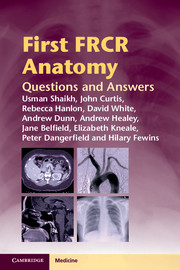Examination 4
Published online by Cambridge University Press: 05 March 2012
Summary
AP radiograph right shoulder
Lesser tuberosity of the right humerus. The subscapularis tendon attaches here. This may rarely become avulsed during hyper-external rotation injury due to traction by the subscapularis tendon insertion.
Greater tuberosity of the right humerus. This forms the bony footprint for the supraspinatus tendon.
Right acromion. The coraco-acromial ligament attaches from here to the coracoid process, forming a roof over the shoulder joint. Bony enthesopathy of this ligament may contribute to subacromial impingement of the supraspinatus tendon and is implicated as a causative factor in the evolution of rotator cuff tears.
Right acromio-clavicular joint. This narrow synovial joint commonly undergoes degenerative changes but may also develop erosions in inflammatory arthropathy.
The antero-inferior glenoid rim. This bears the attachment of the anterior band of the inferior glenohumeral ligament, which is an important static stabilizer of the glenohumeral joint. This region may be fractured during anterior glenohumeral dislocation, producing a bony Bankart lesion.
Coronal T1-weighted MR knee
Medial collateral ligament (MCL). This important ligament arises from the medial femoral condyle and inserts on the medial tibial diaphysis and resists valgus stress of the knee.
Posterior cruciate ligament. This strong ligament arises from the lateral surface of the medial femoral condyle and inserts on the posterior intercondylar fossa of the tibia. It is a central stabilizer of the knee resisting posterior tibial translation.
Iliotibial band (ITB). This long structure originates from the fascia of the iliotibial tract and inserts on Gerdy's tubercle on the antero-lateral tibia. Distally it may undergo repetitive friction over the lateral border of the lateral femoral condyle to produce painful distal ITB friction syndrome.
Articular cartilage of medial tibial plateau. This thick layer of hyaline cartilage is composed of four zones or layers. During the evolution of osteoarthrosis the chondral layers may undergo softening, fibrillation, fissures and progressive thinning, ultimately resulting in full-thickness cartilage loss and sclerosis of the exposed sub-chondral bone.
Discoid lateral meniscus. The lateral meniscus is broad, spanning the whole width of the lateral tibio-femoral compartment. This normal variant, if present, is frequently bilateral and should be examined carefully due to the high incidence of degenerative tears with this variant.
- Type
- Chapter
- Information
- First FRCR AnatomyQuestions and Answers, pp. 105 - 112Publisher: Cambridge University PressPrint publication year: 2012



